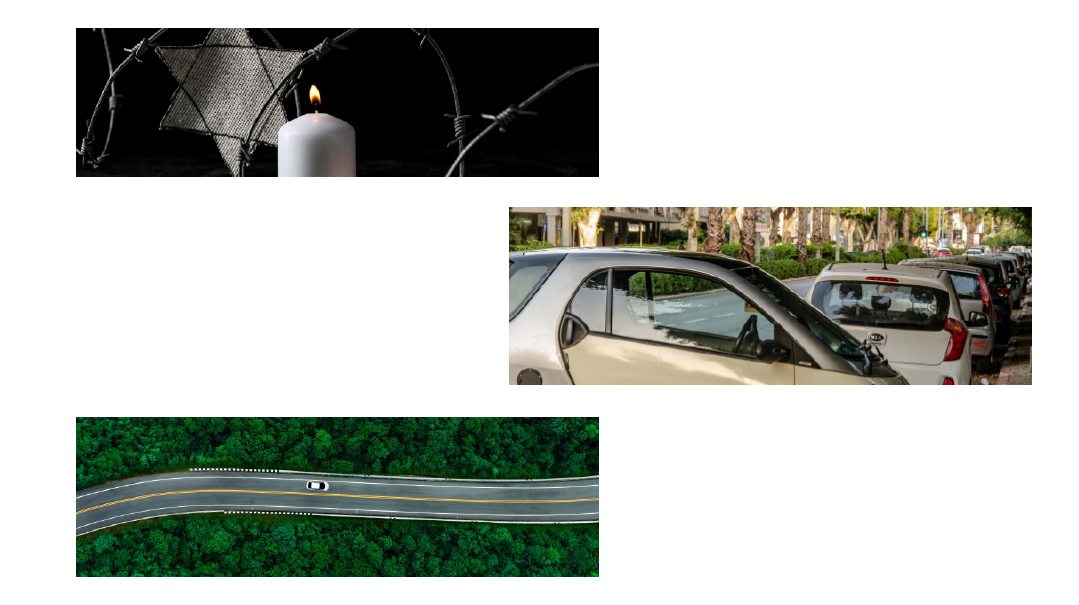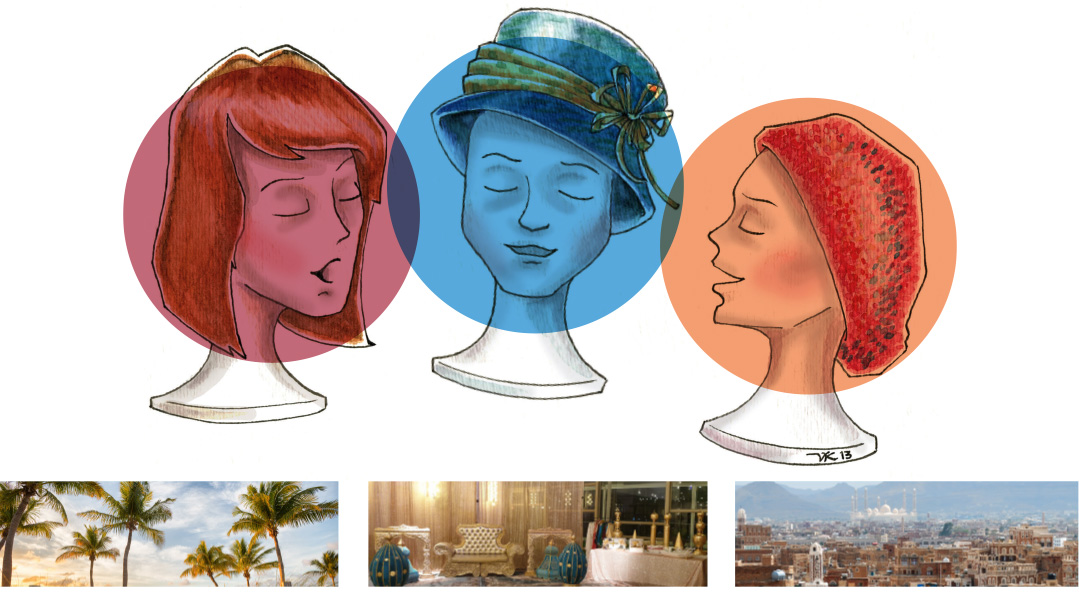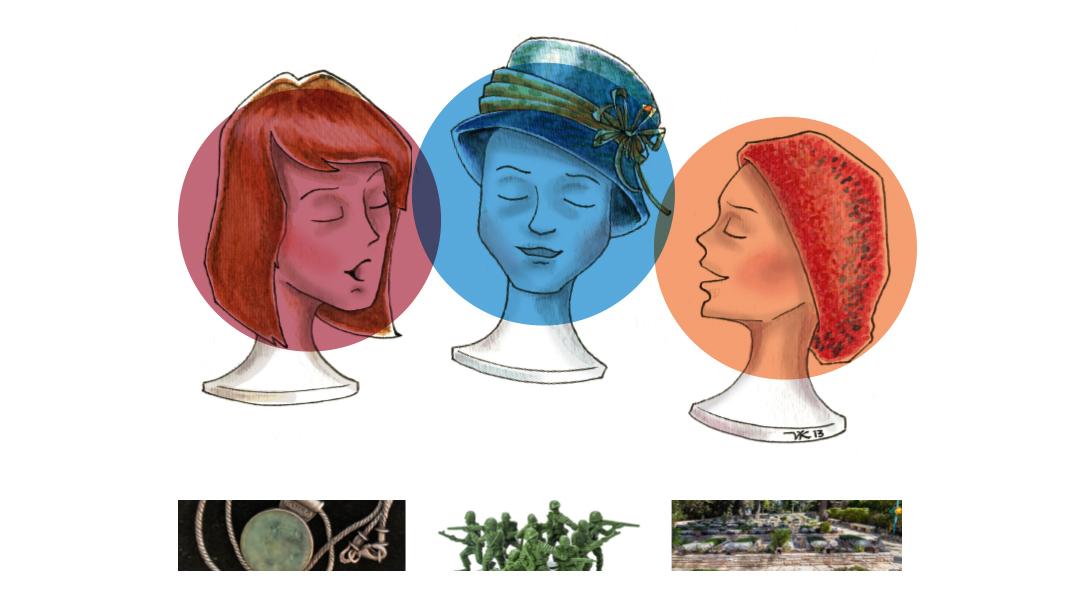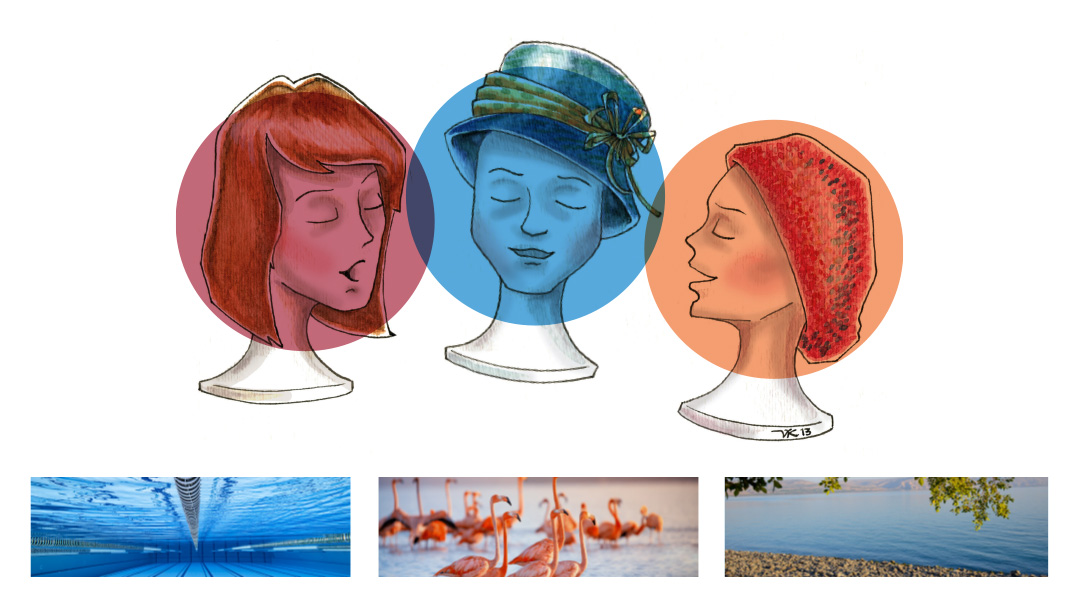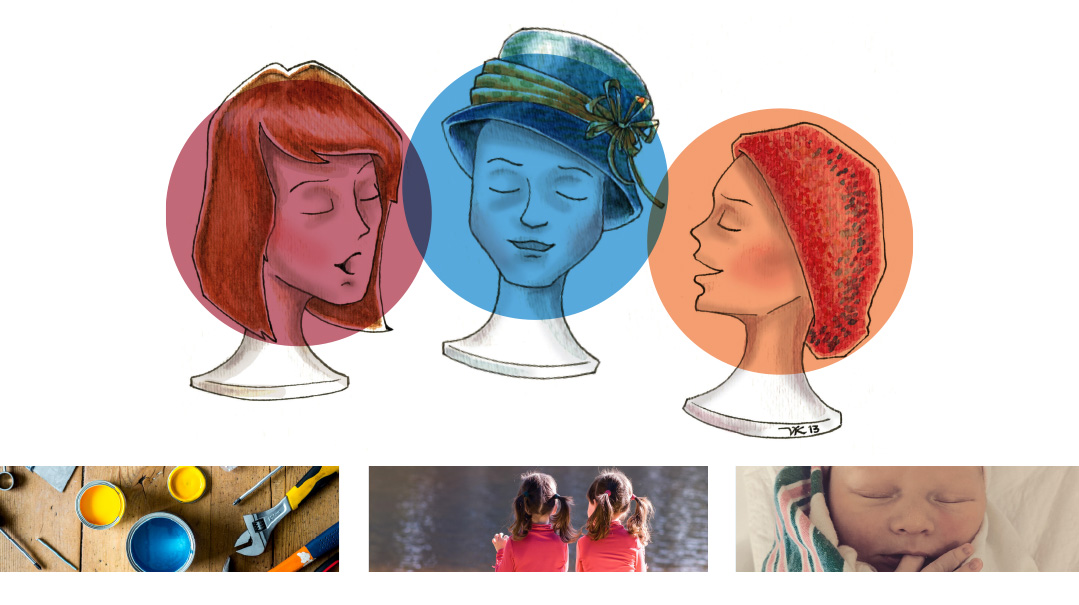The Stories They Tell
| February 1, 2022We Sisters are pleased to share some of the silent, inanimate objects in our lives that schmooze with us
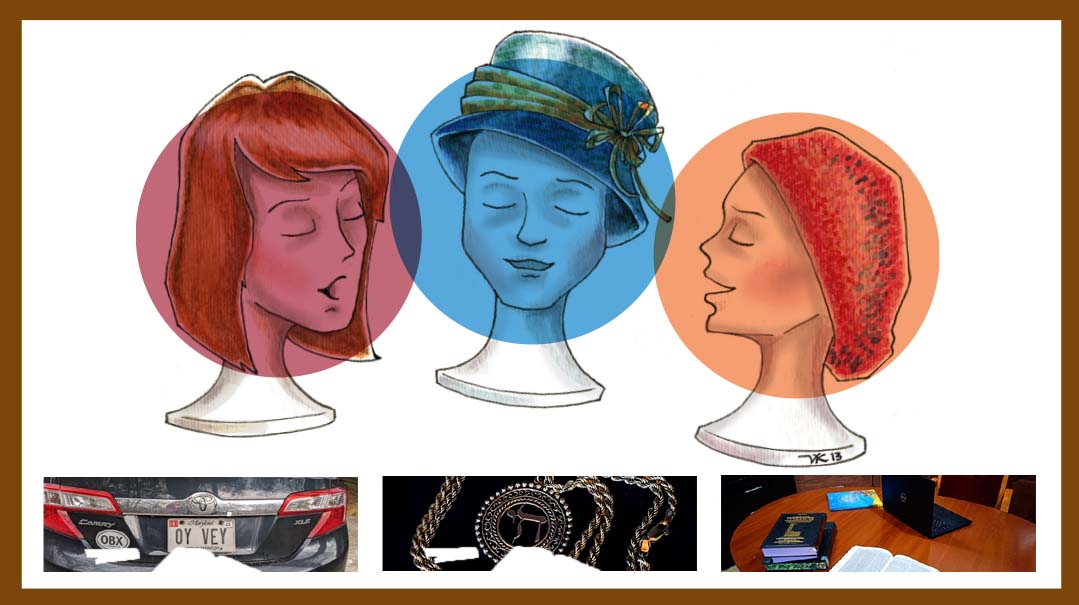
They can be replaced, they don’t feel anything, they can’t speak. They’re just things. Inanimate objects.
So why are there some things that we talk to? Objects we look for frantically when we misplace them? Items we give names to? Things that make us cry when they have to be thrown away?
Maybe it’s because some things tell us about ourselves, become part of our identity. Some items trigger memories. Some lifeless, silent object can tell us a story.
Whether the object was built by a carpenter, crafted by a goldsmith, or even hammered out by an inmate in a prison workshop…. we Sisters are pleased to share some of the silent, inanimate objects in our lives that schmooze with us. The things that tell us stories — if we listen closely.
Marcia fights the battle of…
OY VEY Versus the MVA
Why am I crying at the Maryland Motor Vehicles Administration? It’s just a license plate. Or is it?
It started 30 years ago, when my late husband got me a gift for a milestone birthday (I’m not saying which). Something I’d been hinting at for years: vanity plates for my car. Plates that summed up my life outlook: OY VEY.
Sheldon would tease that it sounded kvetchy, especially compared to his own upbeat BITOCHN tags. “It’s all in how you say it,” I’d respond, “With a whine? or with a chuckle!”
Over the years, most people agreed with my chuckle perspective. Waiting at a red light, drivers in the lane beside me would often roll down their window to make witty comments. At gas stations, drivers pumping gas behind me would ask if they could take a picture. Once, in a parking lot, a man in a suit asked permission to photograph the plates so he could show it “to all my Jewish colleagues at work.”
I’ve probably avoided dozens of parking and speeding tickets over the years because of cops with a sense of humor.
OY VEY was transferred five or six times as we upgraded to new used cars. It always proved to be a self-fulfilling prophecy: Those cars usually started out in decent condition, but degenerated to oy vey shape by the time we were ready to move up.
Once, when we graduated to a Town & Country minivan, we gave our old Taurus station wagon to our son, then attending Chofetz Chaim in Queens. To our mutual dismay, the MVA wouldn’t allow us to transfer OY VEY. I felt as if I’d handed over my identity. My son Nachum just felt mortified.
To make matters worse, Nachum came out of yeshivah one morning to find… the plates had been stolen! We figured they were hanging in some college student’s dorm room. And — adding insult to injury — since the plates were stolen, the MVA wouldn’t let me get the same ones. It took years before they allowed me to regain my identity.
My MVA battles didn’t end there. Early in the pandemic, I got an ominous email: There was a “flag” on my registration record. After weeks of clicking through their user-hostile website, I figured out what the flag was: My husband had the nerve to pass away. His name needed to be removed from the car’s title.
Of course, I had no idea where Sheldon had stored the title document.
The next few Covid months were spent navigating phone message trees, waiting on hold to reach a human, filling out online forms, and snail-mailing paper forms… along with enclosed checks.
I’m convinced that the MVA — like most banks, insurance firms, and utility companies — has a special department known as TWO: the Torture Widows Office.
Liberation from Covid Incarceration. Time for face-to-face battle. The MVA has become my home away from home. After five painfully long visits, I finally get new title and registration documents… with one hitch: They hand me two new license plates. WITH NUMBERS!
“Take off your old OY VEY plates. Turn them in tomorrow at the main office.”
Tearfully, I try explaining that my identity is being peeled away layer by layer — from wife to widow, from employee to retiree, from OY VEY to… boring.
TWO doesn’t care.
“You can apply for new vanity plates. If there’s no waiting list for OY VEY, you should get them in about six months. The prisons have a plate-making backlog due to Covid.”
Oy vey.
I drive to my mechanic, Noah, son of a friend. As he detaches OY VEY, he mournfully reminisces, “I’d always see OY VEY and BITOCHN in the shul parking lot. They were part of my childhood. Now they’re both… gone.”
I drive to the main MVA office to return OY VEY and make one last plea. Another teary hour-and-a-half runaround. Finally… a human with some compassion (hope she doesn’t get fired). I hand her another check. She hands back OY VEY.
I drive straight back to Noah. As he switches the plates again, we ecstatically proclaim victory. OY VEY wins again!
Miriam learns from
My Shulchan Aruch
The table was huge. Big enough for little twin girls to play under, to use as a hideout, as a stage for endless imagination games and dramas. For a while the space under the table even served as a pretend UPS truck, in tribute to the two superheroes dressed in brown uniforms who’d delivered it.
And what fun to race around it, pretending to be the cartoon mice Pixie and Dixie, with big sister Marcia as Mr. Jinx the Cat yelling, “I hate you meeces to pieces!”
This sparkling, magical dining room table was made of cherrywood, Mommy told us. And its warm brown color with hints of black and yellow seemed to come straight from the tree that George Washington had cut down.
Even after Emmy Leah and I could no longer fit underneath it to play our imagination games, the dining room table was there, symbol of stability, of family, of the beauty of Torah life. Long before the word “kiruv” became part of the Jewish lexicon, our nonreligious relatives would sit around it at the Pesach Sedorim, enjoying Mommy’s incomparable gefilte fish, borscht, and chicken soup with knaidlach — and strengthening their fraying bonds with Yiddishkeit. (And if the Fifth Question for some of them was “When do we eat?” that was also okay; at least they were there.)
Strangely, the table seemed to grow smaller as our family grew larger. Marcia’s role as Mr. Jinks faded in memory; now, she was a glowing kallah, bringing her chassan, Sheldon, to our home. Friends and relatives gathered to celebrate the vort around it. No miniatures, no ice fountains, not even a caterer — just old fashioned nachas, simchah, and love, served with Jell-O and fruit and sponge cake on our dining room table.
And then, amazingly, Marcia was a mommy, and Emmy Leah and I were teenage aunts. The Prince (first grandchild on both sides!) was born on Shabbos, at a time when there was no eiruv in our community. Someone suggested that we ask one of our non-Jewish neighbors to bring the baby to shul, just a block away, for the bris. Daddy, usually so quiet and easygoing, spoke with firm determination: “I’m not going to have a goy be my grandson’s kvatter.” And so Prince Avi was brought into the bris of Avraham Avinu on a chair beside the cherrywood table.
Even a sefer Torah, says the Zohar, has its mazel, and so, apparently, does furniture. Decades after those UPS delivery guys had first brought it to our home, the table followed my mother to Eretz Yisrael — she coming on El Al, it traveling in a ship’s container.
Mommy was 72, the table must have been about 30 years old — and both created satisfying and productive new lives in their new home. Shabbos afternoons, Mommy would hold her “salon” (or should I say a “tish”?) with women young and old coming to hear her memories, share her inspiration and wisdom and good humor, and enjoy her scrumptious buffet, set out on the cherrywood table.
Just hours before her passing, she enjoyed her very last Shabbos meal with Emmy Leah and her husband, Jay, sitting and chatting and laughing around her dining room table.
The table is now ours. Before Covid, on Shabbos the cherrywood table hosted sem girls, yeshivah guys, non-Jews studying for geirus. Nowadays, during the week, it serves as a combined home office and beis medrash, with my computer and papers sharing space with my husband’s piles of seforim. (As a matter of fact, I’m typing this Schmooze on it right now, enjoying its shine and sparkle.)
We Jews are privileged to have a Shulchan Aruch to show us how to live full Torah lives. We Sisters, though, had an additional gift: A “set table,” a shulchan aruch made of cherrywood that taught us lessons about family, about reaching out and accepting those not as Torah-observant as we are. Lessons about pashtus and true simchah and hachnassas orchim and resilience.
When I was five years old, I thought this table was huge. And you know what? I was right.
Emmy Leah hears (and wears) …
A Chain of Stories
Jaffa Gate, some weeks ago. I’m walking back from the Kotel with my husband, wearing my gold chai chain, the necklace my mother a”h gave me before she died. It’s a lovely piece of jewelry, the shining Hebrew letters chai surrounded by delicate filigree circles etched in fine gold.
Despite Covid restrictions, the area is hopping. Chassidim hurrying, tourists listening wide-eyed to their guides, a group of sem girls laughing together. Some young Arab men stand idly by. The usual Old City crowd.
Suddenly, something less usual. One of the Arab men breaks away from his friends and stands in front of me.
“Where did you get that?” he asks in accented English, pointing to my chai.
Taken aback, I answer automatically: “It was my mother’s. She was a Holocaust survivor, and her aunt gave it to her after she was freed from Auschwitz.”
His turn to be taken aback. He stares once more at the chai, mutters “Beautiful,” and walks away.
Slightly shaken, we try to figure out what just happened. My husband, ever practical, suggests that the man might own a stall in the nearby shuk and wanted to buy the chai off me. I, expert at worst-case scenarios, wonder if he’d considered yanking it off my neck and running.
That question remains unanswered. What is clear is that something about the chai and my answer to his question impressed this young Arab. Maybe he’d never met someone related to a Holocaust survivor. Or maybe he’d never seen a piece of jewelry that could tell such a story….
Where to start the chai’s backstory? Perhaps in prewar Munkacs, where my mother, with her eye for detail, noticed an address on letters sent from America by her father’s brother.
That story was brutally interrupted by the Shoah, by the murder of her parents, her young husband, her infant son, three sisters and their families, by her year in Auschwitz, by the torture of slave labor, hunger, death marches.
The story continues in Sweden, where my mother was sent with other young survivors for rehabilitation. She was grateful for the help the Swedish people gave, but when some girls, desperate for family, began marrying Swedish boys, she knew she had to leave. But where could she go?
Palestine? The situation in the DP camps was desperate, so she wasn’t eligible for a certificat.
Back to Munkacs, now under Russian rule? The Russian embassy sent a representative to invite her to come “home;” she reminded him that she had no home in the country that sold her people to the Nazis.
That left America. She had an uncle there. But where?
Slowly my mother’s memory of letters from America returned, and bit-by-bit she remembered her Uncle Eisler’s address in New York. She contacted him, and he sponsored her to come to the United States. She would leave the land of death and destruction and go to her uncle in the land of new hope.
In her writings, my mother described a rough ocean crossing. Despite seasickness, watching the waves pitching around her, she decided: I will cast my tears into those waters and start life again with my father’s brother, the only survivor of my parents’ generation.
Only it didn’t work out that way. Disembarking, ready to start her new life, she discovered that while she was crossing the ocean, her uncle had died. Yet another blow she must survive….
But survive she did. Her aunt, Tante Eisler, took her in. Though her American relatives were kind, my mother, ever independent, was soon learning English and working as a seamstress to pay her own way.
Tante Eisler couldn’t give my mother all she had lost, but she did give her a first home in the US. She gave her a new chance at life.
And she gave her the chai.
I wear the chai often, especially when I go to the Kotel. Somehow, the story the shining ornament tells echoes the story of the ancient stones: a tale of tragedy, of destruction, of renewed hope, of rebuilding… a story of chai.
And then I hear my mother’s voice, as she’d proudly proclaim at every simchah of every child and grandchild in the family she rebuilt: Am Yisrael Chai!
Join us Sisters at the annual inspiring program in memory of our mother. Michlalah’s Rose Stark Memorial Event will take place over Zoom on March 6. Featured speaker: Rav Aaron Lopiansky. Details at engl-jer@michlalah.eduA Chain of Stories
(Originally featured in Family First, Issue 779)
Oops! We could not locate your form.

